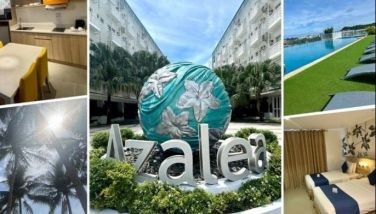Sugbu summer
May 7, 2005 | 12:00am
 Picking up from where we left off last week – summer in Cebu and my recent trip there – there’s no better alternative to the crowded beaches of Boracay. From resorts to a riotous night life, creamy beaches to yummy bulad (dried fish), sun, sea, and shopping (world-class home décor and furniture) – try Cebu.
Picking up from where we left off last week – summer in Cebu and my recent trip there – there’s no better alternative to the crowded beaches of Boracay. From resorts to a riotous night life, creamy beaches to yummy bulad (dried fish), sun, sea, and shopping (world-class home décor and furniture) – try Cebu.
Like I mentioned last week, Cebu city itself is not as messed up by billboards and blight as Metropolitan Manila. Of course, Cebu is not as big and it does have its share of problems. I wandered around the city center from Fort San Pedro – relatively well-maintained – to Carbon market, the hardware district, and back to the port of Cebu.
Like downtown Manila, Cebu City developed as a center for trade and commerce. Cebu was actually established a few years ahead of Manila in 1565. It was the first base of the Spaniards before they sought a location nearer the South China Sea, which was Manila. Colon, Magallanes, and Carbon streets in Cebu City are, in fact, the oldest Spanish-era commercial streets in the Philippines. The rest of the city grew out of the old Laws of the Indies template of church, plaza, and government buildings. Like Manila in the 20th century, Cebu expanded out from its fort and port to head inland towards the mountains. Two- and three-story commercial structures lined the central districts in the 1950s onwards, modeled after arcaded walks similar to Avenida Rizal’s. This serves to shelter pedestrians from the rain and sun as well as to maximize ever-shrinking real estate. The arcades are still there doing the job. (It was scorching-hot that day I took my little paseo, but the arcades kept me cool.)
In the last 30 years, Cebu has sprawled out into the hills beyond the capitol building and the Villalon mansion, as well as north and south into adjacent cities. There was nothing surrounding the old Aznar Coliseum or Lahug airport in the 1960s, but today, both landmarks are out of sight or gone forever.
"Greater Cebu" is now home to over a million, though I suspect that it is more than two million, judging from the crowds in the markets and the numerous malls that have sprouted. Covering three cities and six municipalities, this metropolitan cluster is in dire need of coordinated governance and rational physical development controls. Case in point – the new coastal road connecting the city to the southern towns of Naga, Carcar, Sibonga, and Argao bypasses Talisay City. Talisay is claiming part of the reclamation used for that highway as theirs and Cebu City contests this, leading to the road’s closure.
Despite all these problems, Cebu’s old sections have an astonishingly intact stock of pre- and post-war buildings. Warehouses and commercial structures here are a mix of Art Deco structures from the 1930s, hybrid Deco-modern buildings from the ’50s and international-style structures complete with brise soleil (sun shades) also from the ’50s and ’60s. The city should make sure that these examples of utilitarian architecture be conserved. Many still serve the same functions they’ve had since they were built. This is good. What is needed is better maintenance and support from government for pedestrianization and façade upkeep, following the good examples of projects by Manila Mayor Lito Atienza and Quezon City Mayor Sonny Belmonte.
Cebu’s residential suburbs have mushroomed with little rhyme or reason. They are all badly connected to main arteries by labyrinthine rights of way. Palatial houses in the older residential sections near Mango Avenue have been converted into restaurants and Family KTV facilities. There’s good food and music, but little parking space. (Only the Crosswinds cluster provides adequate parking in Urban Cebu.)
Going outside Cebu City, I realized that (aside from Mactan) the rest of the province is underdeveloped for tourism. Wonderful heritage-rich seaside towns and picturesque coastline await local and foreign tourists. Hotels and resorts are few and far between. Many locals have started to build beach homes clustered around beautiful coves and white sands. Cebu architects like Ed Gallego, who trained in the US before returning to Cebu in the early ’90s, are producing tropical architecture that is so comfortable and good-looking they look like they belong in a coffee-table book!
What is needed is better infrastructure. The airport in Mactan is good, but access north and south is bogged down by traffic. Fast catamarans do get you to certain destinations in Cebu, Bohol, and Negros, but the connectivity between international airlines, domestic shuttles, ferries and land transport is neither efficient nor tourism-friendly. Reports have it that the proposed rehabilitation of Cebu’s pre-war railway is a good project that will cost less than one-tenth the cost of similar rail projects in Luzon. This much-needed system would bring people north and south in a jiffy without the attendant cost of highway infrastructure or pollution. (Since it costs less, government departments are not interested – much less kurakot to be made, say most people.)
Despite the deficiencies in physical infrastructure and metropolitan management, Cebu City (as well as the whole province) is still an exciting destination, with great economic possibilities and an unrealized tourism potential that Cebuanos should keep safe from the deleterious effects of politics. See you in Cebu!
BrandSpace Articles
<
>




















